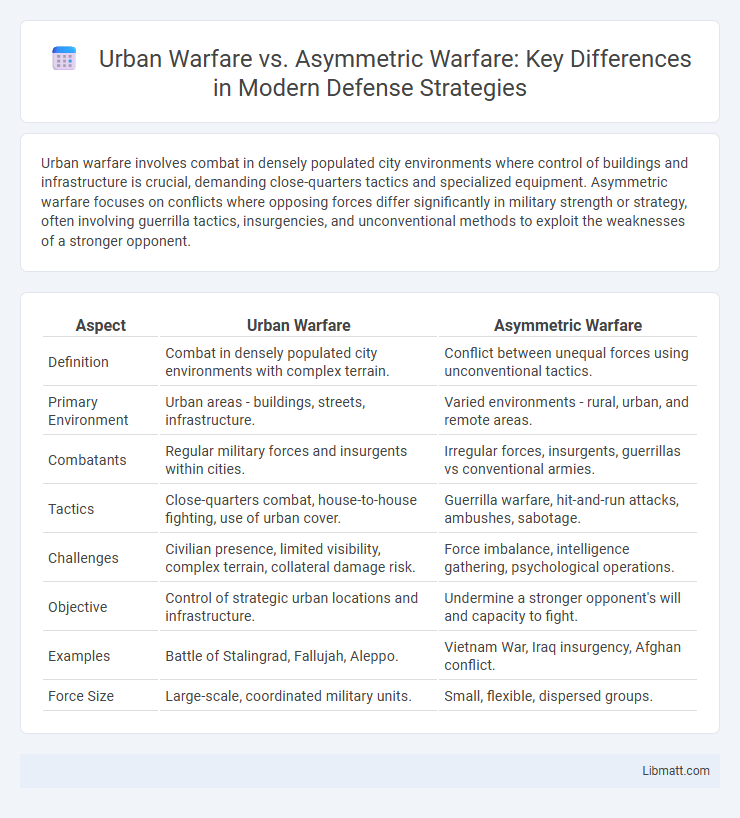Urban warfare involves combat in densely populated city environments where control of buildings and infrastructure is crucial, demanding close-quarters tactics and specialized equipment. Asymmetric warfare focuses on conflicts where opposing forces differ significantly in military strength or strategy, often involving guerrilla tactics, insurgencies, and unconventional methods to exploit the weaknesses of a stronger opponent.
Table of Comparison
| Aspect | Urban Warfare | Asymmetric Warfare |
|---|---|---|
| Definition | Combat in densely populated city environments with complex terrain. | Conflict between unequal forces using unconventional tactics. |
| Primary Environment | Urban areas - buildings, streets, infrastructure. | Varied environments - rural, urban, and remote areas. |
| Combatants | Regular military forces and insurgents within cities. | Irregular forces, insurgents, guerrillas vs conventional armies. |
| Tactics | Close-quarters combat, house-to-house fighting, use of urban cover. | Guerrilla warfare, hit-and-run attacks, ambushes, sabotage. |
| Challenges | Civilian presence, limited visibility, complex terrain, collateral damage risk. | Force imbalance, intelligence gathering, psychological operations. |
| Objective | Control of strategic urban locations and infrastructure. | Undermine a stronger opponent's will and capacity to fight. |
| Examples | Battle of Stalingrad, Fallujah, Aleppo. | Vietnam War, Iraq insurgency, Afghan conflict. |
| Force Size | Large-scale, coordinated military units. | Small, flexible, dispersed groups. |
Defining Urban Warfare: Characteristics and Challenges
Urban warfare involves combat operations conducted in densely populated city environments characterized by complex terrain, including buildings, narrow streets, and underground infrastructure. This type of warfare presents unique challenges such as limited visibility, the presence of civilians, and the difficulty of distinguishing between combatants and non-combatants. Tactics and strategies must adapt to the intricate urban landscape, requiring specialized training, equipment, and intelligence to effectively navigate and control these contested environments.
Understanding Asymmetric Warfare: Key Concepts
Asymmetric warfare involves conflict between forces of unequal strength, where the weaker party employs unconventional tactics such as guerrilla warfare, sabotage, and ambushes to exploit the vulnerabilities of a stronger opponent. Urban warfare, a subset of asymmetric conflict, takes place in densely populated city environments, complicating military operations with civilians, vertical terrain, and limited visibility. Understanding asymmetric warfare requires analyzing its reliance on irregular strategies, psychosocial factors, and the strategic use of terrain to offset conventional military advantages.
Historical Evolution of Urban and Asymmetric Warfare
Urban warfare has evolved from ancient city sieges to complex, close-quarters combat in densely populated environments, driven by technological advancements and changing military tactics. Asymmetric warfare, historically exemplified by guerrilla tactics and insurgencies against conventional forces, has grown in prominence since the 20th century, reflecting shifts in political power and non-state actor influence. Your understanding of modern conflict dynamics improves by examining how both warfare types have adapted to urbanization and the rise of irregular combatants.
Comparative Analysis: Tactics and Strategies
Urban warfare employs close-quarters combat, leveraging buildings and infrastructure for cover, ambushes, and chokepoints, while asymmetric warfare prioritizes unconventional tactics such as guerrilla attacks, sabotage, and psychological operations to exploit the vulnerabilities of a conventionally superior enemy. Urban combat relies on securing strategic positions like rooftops, tunnels, and intersections to control terrain, whereas asymmetric forces emphasize mobility, surprise, and blending with civilian populations to avoid direct confrontations. Commanders in urban warfare adapt traditional military doctrine for dense environments, whereas asymmetric warfare demands flexible, adaptive strategies to counterbalance disparities in firepower and resources.
Terrain Impact: The Role of Urban Environments
Urban environments drastically shape both urban warfare and asymmetric warfare by influencing tactics, movement, and visibility. Narrow streets, high-rise buildings, and dense infrastructure create complex terrain that hampers conventional military operations while favoring guerrilla tactics and ambushes typical of asymmetric warfare. Your strategy must adapt to these challenges by leveraging intelligence, surveillance, and local knowledge to navigate the urban labyrinth effectively.
Technological Innovations in Modern Warfare
Urban warfare demands advanced surveillance systems and precision-guided munitions to navigate densely populated environments and minimize collateral damage. Asymmetric warfare leverages unmanned aerial vehicles (UAVs) and cyber warfare technologies to offset conventional military advantages through stealth and disruption. Both forms of conflict increasingly rely on artificial intelligence and real-time data analytics to enhance situational awareness and decision-making on complex battlefields.
Civilian Involvement and Humanitarian Concerns
Urban warfare often results in high civilian involvement due to dense populations and the proximity of combat zones to residential areas, leading to increased casualties and displacement. Asymmetric warfare frequently targets or exploits civilians as part of irregular tactics, complicating humanitarian efforts and raising ethical concerns. Both forms of conflict demand robust protection mechanisms for non-combatants and adherence to international humanitarian laws to mitigate human suffering.
Case Studies: Notable Urban vs Asymmetric Conflicts
The Battle of Mosul (2016-2017) exemplifies intense urban warfare where Iraqi forces combated ISIS militants entrenched in densely populated neighborhoods, highlighting close-quarters combat and infrastructure challenges. In contrast, the Taliban insurgency in Afghanistan demonstrates asymmetric warfare tactics, using guerrilla attacks and ambushes against conventional NATO forces, capitalizing on mobility and local support. Your understanding of modern conflicts is enhanced by analyzing these distinct case studies, revealing how terrain and tactics shape strategic outcomes.
Training and Preparation: Military Adaptations
Urban warfare demands specialized training in close-quarters combat, navigation of complex environments, and civilian interaction, while asymmetric warfare requires adaptability to unconventional tactics and irregular threat patterns. Military adaptations involve enhanced simulation technologies, urban terrain mock-ups, and counterinsurgency techniques to prepare forces for both environments. Your strategic readiness improves significantly by integrating these focused training modules tailored to the distinct challenges of urban and asymmetric conflicts.
Future Trends: Evolving Dynamics in Urban and Asymmetric Warfare
Future trends in urban warfare emphasize increased use of advanced technology such as drones, AI-driven surveillance, and precision-guided munitions to navigate complex city environments. Asymmetric warfare continues to adapt with non-state actors leveraging cyber capabilities, guerrilla tactics, and information warfare to exploit vulnerabilities in traditional military forces. Your strategic approach must integrate these evolving dynamics to effectively address both densely populated urban combat zones and unconventional threats.
Urban warfare vs Asymmetric warfare Infographic

 libmatt.com
libmatt.com